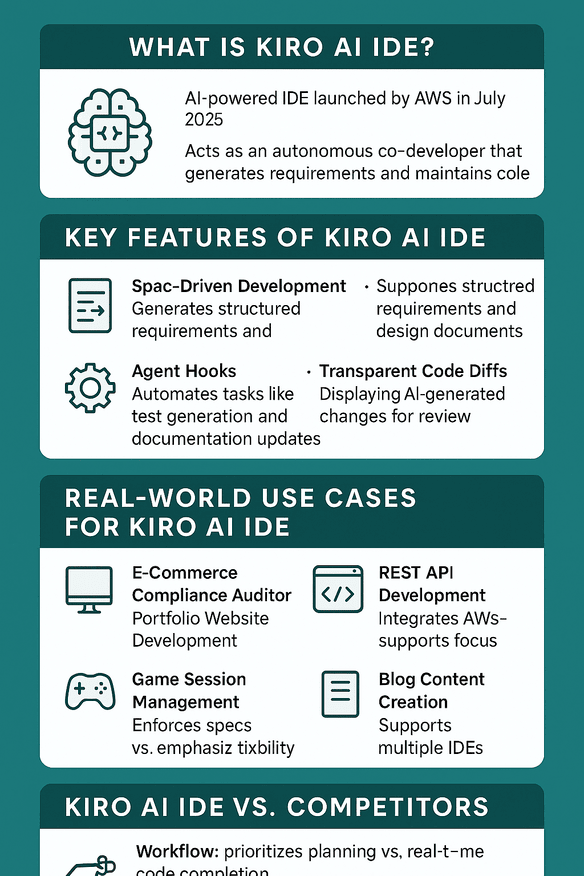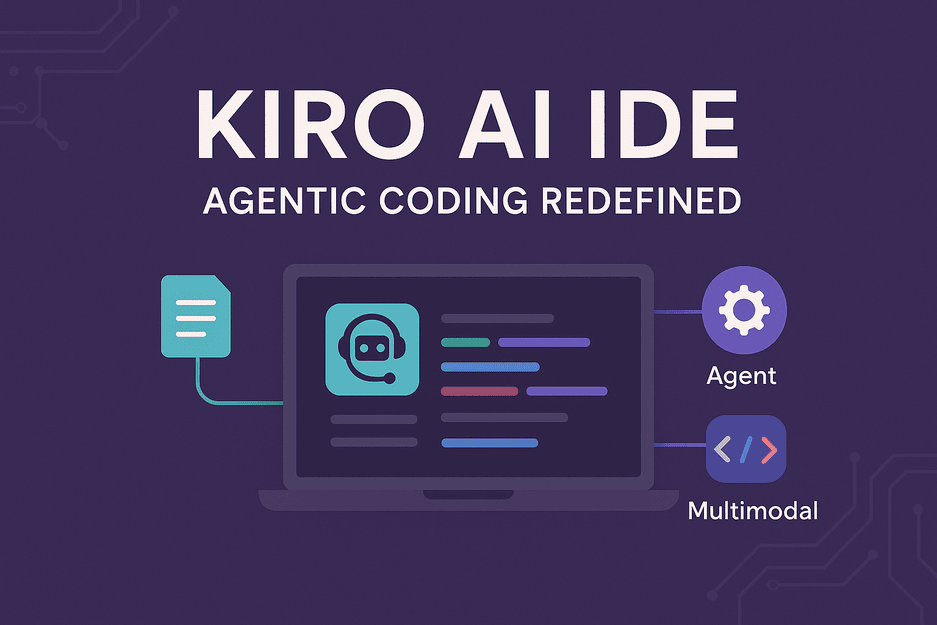What Is Kiro AI IDE?
Kiro is an AI-powered Integrated Development Environment (IDE) launched by AWS in July 2025, built on the open-source Code OSS platform, designed to transform software development through spec-driven workflows and agentic AI. Unlike traditional IDEs, Kiro acts as an autonomous co-developer, generating structured requirements, design documents, and task lists from natural language prompts, ensuring maintainable, production-ready code. Powered by Anthropic’s Claude Sonnet 4.0 and 3.7 models, it integrates with AWS Bedrock and supports multimodal inputs, making it a standout in AI-driven coding.
Key Features of Kiro AI IDE
- Spec-Driven Development: Kiro generates requirements.md, design.md, and tasks.md files from prompts, ensuring structured planning. Claude’s natural language processing enhances requirement clarity.
- Agent Hooks: Automates tasks like test generation and documentation updates on file changes. LangChain’s agentic workflows streamline repetitive processes.
- Multimodal Context: Supports text, images, and code inputs for context-aware coding. Hugging Face Embeddings improve Kiro’s understanding of visual diagrams.
- Agent Steering: Customizable markdown files (product.md, tech.md) define project vision and tech stack. Claude’s contextual reasoning tailors outputs to project needs.
- Transparent Code Diffs: Displays AI-generated changes as side-by-side diffs for review. OpenAI’s GPT-4-like reasoning ensures accurate code suggestions.
- MCP Server Integration: Connects to external tools and APIs via Model Context Protocol. LangChain enables seamless API integrations for enhanced functionality.
- VS Code Compatibility: Retains VS Code settings and Open VSX plugins. Claude’s model support ensures familiarity for developers.
Real-World Use Cases for Kiro AI IDE
- E-Commerce Compliance Auditor: A developer used Kiro to build a serverless AI Compliance Auditor for e-commerce, integrating Amazon Nova Premier Model via AWS Bedrock for review moderation, completed in days instead of weeks.
- Portfolio Website Development: Kiro created a TanStack Start and React-based portfolio site, generating specs and code with shadcn components, leveraging Claude for design consistency.
- Game Session Management: Kiro developed a volunteer rota app with React, Node.js, and PostgreSQL, using LangChain for task automation and Claude for spec generation.
- REST API Development: A team built a product review system with RESTful APIs, using Kiro’s Claude-powered task sequencing and LangChain for automated testing.
- Blog Content Creation: Kiro assisted in writing a blog post by generating structured narrative specs, powered by Claude’s text generation capabilities.
What We Love About Kiro AI IDE
- Structured Workflow: Spec-driven development reduces technical debt by syncing code and documentation, powered by Claude’s precise requirement analysis.
- Automation Power: Agent Hooks automate testing and security scans, leveraging LangChain’s agentic capabilities to save time.
- Multimodal Flexibility: Integration of images and code context via Hugging Face Embeddings enhances project accuracy.
- Enterprise-Ready: Automatic documentation updates and audit trails, supported by AWS Bedrock, ensure compliance and scalability.
- Familiar Interface: Built on Code OSS, Kiro feels like VS Code, easing adoption with Claude’s model support.
What Needs Work in Kiro AI IDE
- Performance Reliability: Early users reported high-load errors, like “model experiencing high traffic,” suggesting Claude model scalability issues; DeepSeek could offer a fallback.
- Learning Curve: Spec-driven workflows may slow agile teams; QWEN’s simpler interfaces could streamline onboarding.
- Limited Model Options: Relies heavily on Claude; integrating OpenAI or DeepSeek models could enhance flexibility.
- Debugging Challenges: Kiro struggles with complex setups like Prisma database connections; Perplexity’s debugging tools could improve error handling.
Kiro AI IDE vs. Competitors

- Kiro vs. GitHub Copilot:
- Workflow: Kiro’s spec-driven approach (Claude-powered) emphasizes planning; Copilot (OpenAI-based) focuses on real-time code completion.
- Automation: Kiro’s Agent Hooks (LangChain) automate testing; Copilot lacks autonomous task execution.
- Price: Kiro’s free tier offers 50 interactions; Copilot’s $10/month is cheaper for individuals.
- Kiro vs. Cursor:
- Context: Kiro’s multimodal inputs (Hugging Face Embeddings) outshine Cursor’s code-focused context.
- Structure: Kiro enforces specs; Cursor (OpenAI-driven) prioritizes flexibility.
- Ecosystem: Kiro integrates AWS Bedrock; Cursor supports broader IDE plugins.
- Kiro vs. Windsurf:
- Scalability: Kiro’s enterprise focus (AWS Bedrock) suits teams; Windsurf (smaller-scale) is less robust.
- AI Integration: Kiro’s Claude and LangChain outperform Windsurf’s limited model support.
- Cost: Kiro’s Pro tier ($19/month) is pricier than Windsurf’s free model.
- Kiro vs. Amazon Q Developer:
- Scope: Kiro’s standalone IDE (Claude) contrasts Q’s AWS-specific focus.
- Automation: Kiro’s hooks (LangChain) surpass Q’s basic suggestions.
- Flexibility: Kiro’s cloud-agnostic design trumps Q’s AWS dependency.
Pricing for Kiro AI IDE
Kiro offers a free tier with 50 agentic interactions per month, ideal for testing. The Pro tier ($19/month) provides 1,000 interactions, and Pro+ ($39/month) offers 3,000, with additional interactions at $0.04 each. No extra costs for AI tools like Claude or AWS Bedrock are noted, but enterprise plans may vary. Pricing details are available at kiro.dev.
Final Verdict
Kiro AI IDE is a game-changer for teams seeking structured, production-ready coding, leveraging Claude and LangChain for unmatched automation and clarity. Its learning curve and reliance on Claude models need refinement, but it’s a must-have for enterprises prioritizing maintainable code. Rating: 4.5/5.
